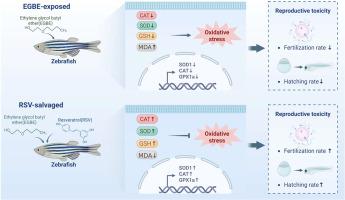Resveratrol attenuates ethylene glycol butyl ether-impaired zebrafish fertility via antioxidant mechanism
IF 4.3
2区 环境科学与生态学
Q1 MARINE & FRESHWATER BIOLOGY
引用次数: 0
Abstract
Industrial pollutants and their metabolite derivatives constitute formidable threats to aquatic ecosystems upon environmental discharge. Ethylene glycol butyl ether (EGBE), an extensively employed organic solvent prevalent in industrial and household products, exhibits well-characterized reproductive toxicity. This investigation evaluated the protective effect of resveratrol (RSV) against EGBE-induced reproductive toxicity in zebrafish ovaries. Findings revealed that subsequent to EGBE (200 mg/L for 20 days), both fertilization rate (from 83.39 % ± 2.37 % to 55.70 % ± 1.91 %, p < 0.05) and hatching rate (from 91.06 % ± 3.69 % to 48.87 % ± 2.25 %, p < 0.05) manifested significant decrements. Transcriptomic analysis unveiled dysregulation of oxidative stress-associated genes, whereas functional enrichment analysis demonstrated differential gene expression clustering within the lysosome, Notch signaling pathway, Apelin signaling pathway, and biosynthesis of unsaturated fatty acids pathways—all fundamental to oxidative stress regulation. EGBE concurrently compromised the endogenous antioxidant system through modulation of superoxide dismutase (SOD) and catalase (CAT) enzymatic activities, concomitant with perturbations in glutathione (GSH) and malondialdehyde (MDA) levels. Finally, RSV restored ovarian SOD and CAT activities functionality, augmented GSH concentration, attenuated MDA concentration, increased the fertilization rate (from 55.70 % ± 1.91 % to 88.27 % ± 1.17 %, p < 0.05) and hatching rate (from 48.87 % ± 2.25 % to 93.06 % ± 1.66 %, p < 0.05). In summary, our research data substantiate that RSV ameliorates reproductive toxicity in zebrafish caused by EGBE. Nevertheless, comprehensive investigation remains requisite to elucidate EGBE’s chronic ecological ramifications and multi-trophic impacts.

白藜芦醇通过抗氧化机制降低乙二醇丁基醚损伤的斑马鱼的生育能力
工业污染物及其代谢物衍生物在环境排放后对水生生态系统构成巨大威胁。乙二醇丁基醚(EGBE)是一种广泛应用于工业和家用产品的有机溶剂,具有良好的生殖毒性。研究了白藜芦醇(resveratrol, RSV)对egbe诱导的斑马鱼卵巢生殖毒性的保护作用。结果表明,在EGBE (200 mg/L)处理20 d后,受精率(从83.39%±2.37%降至55.70%±1.91%,p < 0.05)和孵化率(从91.06%±3.69%降至48.87%±2.25%,p < 0.05)均显著降低。转录组学分析揭示了氧化应激相关基因的失调,而功能富集分析表明,溶酶体、Notch信号通路、Apelin信号通路和不饱和脂肪酸生物合成途径中的差异基因表达聚类,这些都是氧化应激调节的基础。EGBE同时通过调节超氧化物歧化酶(SOD)和过氧化氢酶(CAT)的酶活性,同时伴有谷胱甘肽(GSH)和丙二醛(MDA)水平的扰动,损害内源性抗氧化系统。最后,RSV恢复卵巢SOD和CAT活性功能,增强GSH浓度,减弱MDA浓度,提高受精率(从55.70%±1.91%提高到88.27%±1.17%,p < 0.05)和孵化率(从48.87%±2.25%提高到93.06%±1.66%,p < 0.05)。综上所述,我们的研究数据证实RSV可改善EGBE对斑马鱼的生殖毒性。然而,全面的调查仍然需要阐明乙二醇单丁醚的慢性生态后果和多营养影响。
本文章由计算机程序翻译,如有差异,请以英文原文为准。
求助全文
约1分钟内获得全文
求助全文
来源期刊

Aquatic Toxicology
环境科学-毒理学
CiteScore
7.10
自引率
4.40%
发文量
250
审稿时长
56 days
期刊介绍:
Aquatic Toxicology publishes significant contributions that increase the understanding of the impact of harmful substances (including natural and synthetic chemicals) on aquatic organisms and ecosystems.
Aquatic Toxicology considers both laboratory and field studies with a focus on marine/ freshwater environments. We strive to attract high quality original scientific papers, critical reviews and expert opinion papers in the following areas: Effects of harmful substances on molecular, cellular, sub-organismal, organismal, population, community, and ecosystem level; Toxic Mechanisms; Genetic disturbances, transgenerational effects, behavioral and adaptive responses; Impacts of harmful substances on structure, function of and services provided by aquatic ecosystems; Mixture toxicity assessment; Statistical approaches to predict exposure to and hazards of contaminants
The journal also considers manuscripts in other areas, such as the development of innovative concepts, approaches, and methodologies, which promote the wider application of toxicological datasets to the protection of aquatic environments and inform ecological risk assessments and decision making by relevant authorities.
 求助内容:
求助内容: 应助结果提醒方式:
应助结果提醒方式:


